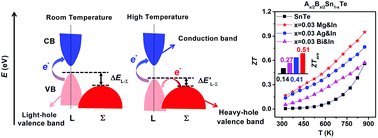Enhanced thermoelectric performance through synergy of resonance levels and valence band convergence via Q/In (Q = Mg, Ag, Bi) co-doping†
Abstract
The temperature-dependent evolution of heavy-hole valence band contribution to the Seebeck coefficients of SnTe-based thermoelectric materials is revealed in situ by neutron and synchrotron powder diffraction. The additional carriers with high effective mass are created in a heavy-hole valence band above 493 K, which contribute to the electrical transport, and lead to a significant enhancement of the Seebeck coefficient at high temperature. In addition, remarkably improved electrical transport properties are achieved through the synergetic effects of the resonance levels, the valence band convergence, and the carrier concentration optimization by co-doping with Mg & In, Ag & In and Bi & In. Significant reduction in the lattice thermal conductivity is obtained by multiscale phonon scattering over a wide spectrum via atomic point defects, nanoscale elongated screw dislocations with random directions, and the microscale grain boundaries caused by sintering. As a result, a high figure of merit, ZT, of ∼1 at 873 K is obtained for the Mg0.015In0.015Sn0.97Te sample.

- This article is part of the themed collection: 2017 Journal of Materials Chemistry A HOT Papers


 Please wait while we load your content...
Please wait while we load your content...